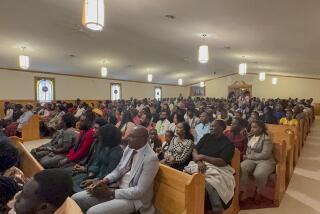Black Flood Victims Charge Bias in Allotting Relief Aid : Disaster: Residents of Missouri town say workers sandbagged white areas, not theirs. Now, federal rules are adding to their problems.
CRYSTAL CITY, Mo. — Both tempers and the temperature sizzled in Crystal City High School’s auditorium when a meeting between flooded residents and representatives of relief agencies turned into an angry debate, with black flood victims charging that the town is discriminating against them as it parcels out its disaster assistance.
Like many cities and towns along the Mississippi and Missouri rivers, Crystal City was caught off guard by the size of flood. The neighborhood hardest hit was Ward 1, the oldest section of town and the one most vulnerable to the river, where most of the residents are black.
While sandbag brigades toiled to keep back the waters in the more affluent, white neighborhoods threatened by the flood, no such work took place in the black community.
“The city of Crystal City did not care at all about the black community,” Marie Russell, 48, a school custodian and bus driver whose home and a house she inherited from her grandmother were filled with 10 to 12 feet of water when the Mississippi crested at the city 40 miles south of St. Louis.
City officials defend their actions, saying that they did not organize sandbagging anywhere in the city--they merely supplied sand and bags to communities that asked for them. They even sent a pile of sand to Ward 1, Debbie Johns, the city clerk, said, but no one bagged it.
“I don’t know what the answer is, but it certainly isn’t racism,” Johns added.
The massive flood that has plagued the Midwest this summer has shined a spotlight on the best and the worst in communities up and down the river. Most of the television footage has shown heart-warming scenes of neighbors helping neighbors and strangers pitching in as well. But in Crystal City, the flood appeared to touch a raw nerve.
Dan Sides, a white man who attended the meeting to get answers from officials about his chances to replace the trailer home he lost in the flood, said he agreed with the assessment of the black residents.
Standing outside to catch some relief from the smothering heat in the auditorium, Sides said he too felt that “racism” was behind the city’s failure to respond to the needs of Ward 1.
“It happened in there too,” Sides, 40, a mechanic, said, gesturing toward the auditorium. “A black lady asked a question, and they curtly told her about an 800 number she could call for an answer. My wife later asked the same question and they spent several minutes trying to give her a satisfactory answer.”
Vincent Bingham, a black man who represents Ward 1 on the City Council, conceded that the failure of his constituents to organize and protect themselves reflects that they have “given up” after years of insufficient responses to their cries for help.
He contended that city hall was largely responsible because 10 or 12 houses were already lost to the waters before the city dropped off the first load of sand. By then, residents knew they would be fighting a losing battle, he said. City officials failed to give the residents the information they needed to understand how serious this flood would be, he added.
Neither the people of Ward 1’s troubles nor the city’s negligence ended as the floodwaters began to recede, Bingham charged.
The city ordinance, made after federal pressure, forbids residents to rebuild their homes if damage to the structures is more than 50% of the cost of the house, unless they elevate the building to one foot above flood stage.
“Some of that area is so low that you would have to take an elevator to get to some of those homes if they were rebuilt according to code,” Johns, the city clerk, said.
Johns said she knows that Ward 1 is “really going to get hit hard,” by this rule. While federal disaster relief may cover rebuilding some of the homes, it will not cover elevating them, which costs about $10,000.
“For a week and a half I’ve been telling city hall we need to tell the people that,” Bingham said. “They act like the people are too dumb so they don’t even explain it. They don’t give them a fair chance.”
Johns realizes that once the residents are told, she’ll face even harsher charges of racism.
“It’s going to be worse, but you can’t compromise on people’s health and safety to avoid accusations of racism,” Johns said.
The flood caused worse damage in their neighborhood, black residents say, because a landfill created to support a huge Wal-Mart, a discount store, forced the water higher in their area.
“They called it progress,” Russell scoffed. “That’s progress. Wal-Mart gets built and my house and 40 others on County Road get knocked under water.”
Bingham and the black residents at the meeting in the high school auditorium say that the city’s treatment of the black community during the flood provides a glimpse at a chronic problem of official racism in the Mississippi River town of 4,000 residents.
The city has long failed to adequately address the problems that face Ward 1, like violence, crime, unemployment and ingrained poverty.
“Black people are good enough to win football games for Crystal City High, but after high school, they’re no good for anything,” Bingham said. “They don’t want black people to get ahead in life.”
But Dennis Riney, another black resident at the meeting, said he is hopeful that the experience of the flood will help break down the “color barrier” in town.
“This is forcing us to communicate,” Riney said. “Now we can address a whole lot of existing problems because we have the lines of communication open.”
More to Read
Sign up for Essential California
The most important California stories and recommendations in your inbox every morning.
You may occasionally receive promotional content from the Los Angeles Times.










